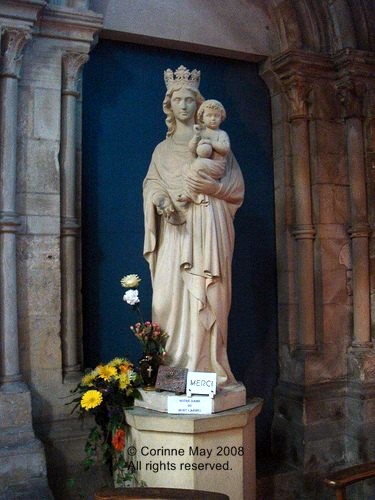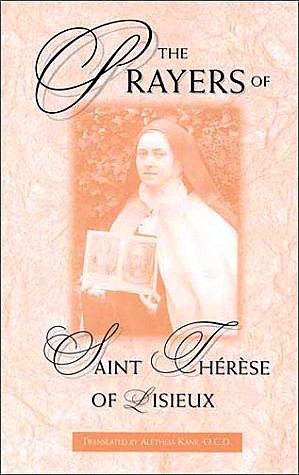Saint Therese of the Child Jesus
of the Holy Face
Entries in writings of St. Therese (1)
125 years ago with St. Therese: July 16, 1895: "Prayer to Jesus in the Tabernacle" for Sister Martha of Jesus
"Prayer to Jesus in the Tabernacle" of St. Therese of Lisieux: July 16, 1895

The statue of Our Lady of Mount Carmel before which Pauline Martin was praying in St. Jacques Church in Lisieux on February 16, 1882 when she understood that she was called to Carmel. This statue is now in st. Pierre's Cathedral in Lisieux. My thanks to Corinne May for the photo.
Sister Martha of Jesus
In the Lisieux Carmel, July 16, 1895 was not only the feast of Our Lady of Mount Carmel but also the 30th birthday of Sister Martha of Jesus, a lay-sister eight years older than Therese who had entered Carmel about three months before Therese. They had spent their time of formation together. Sister Martha became so attached to Therese that she asked to stay in the novitiate permanently so that she might continue to benefit by Therese's good advice.
The "Prayer to Jesus in the Tabernacle"
Therese wrote the "Prayer to Jesus in the Tabernacle" as a birthday present for Sister Martha. The lay-sisters, who got up even earlier than the other nuns and did much of the community's domestic work, were not obliged to stay up for Matins. Sister Martha was the community's hard-working cook. Her day ended with a visit to the Blessed Sacrament at about 8:00 p.m. In this visit she included her examination of conscience, and the editors of The Prayers of Saint Therese of Lisieux point out that the text suggests that she had asked Therese for a prayer to help in this examination.
This prayer, written soon after Therese's "Offering of myself as a victim of holocaust to the Merciful Love of God," is important to understanding Therese and has, I believe, been somewhat overlooked to date.1 Thanks to the generosity of the Washington Province of Discalced Carmelites and the Web site of the Archives of the Carmel of Lisieux, you can read it online. Yet, because the introduction and the notes, which do not appear online, contribute much to our understanding of Sister Martha and of the prayer, I strongly recommend consulting the volume The Prayers of Saint Therese of Lisieux.
Sister Martha, who had lost her mother at age four, spent her childhood in two different orphanages, and lost her father when she was no more than twelve, was marked all her life by the lack of maternal affection and of a stable early home. Despite a sincere devotion, she found it hard to live peacefully with those around her. Therese acknowledges the faults this sister will have to confront on many evenings:
If I were more united to You, more charitable with my sisters, more humble and more mortified, I would feel less sorrow when I talk with you in prayer.
Yet, in a personal Theresian note, "very far from becoming discouraged, I come to you with confidence." The line "I beg You to act in me despite my resistance" speaks to the spirit of contradiction with which Sister Martha had to contend. Therese assures her boldly that on "the last evening of my life" she will reach at once "the unending day of eternity, when I will place in your Divine Heart the struggles of exile!" This conviction that those who trust in love will go straight to heaven, which, as we have seen, marked Therese in a conversation with Sister Febronie before the latter's death in 1892, seems to find more frequent expression starting in 1895.
Sister Martha's later life
Therese's relationship with Sister Martha is vital to a full understanding of Therese and of her life in the community, and I hope to examine it further. Despite her lack of formal education, Sister Martha was an important witness at both processes, speaking simply and in rich detail of what she observed in Therese during the nine years they spent together. Happily, in the end Sister Martha received the grace of the confidence Therese modeled for her. Before her death at age 51, she received the last sacraments on August 28, 1916. She said:
During the ceremony I felt the presence of our little saint. It was like a heavenly voice that said in my ear, “You too, if you wish in spite of your poor life, you can go straight to heaven” and I understood that the greatest sinner could obtain this grace through confidence and humility.2
May the companion for whom Therese wrote this prayer draw us all to the same bold confidence that brought Sister Martha to the Divine Heart.

Footnotes:
1. The autograph of the prayer was destroyed; we have only a copy, which was fortunately made to be submitted to the Process of Therese's writings before the autograph was burned. Most of Sister Martha's private papers were burned after her death to prevent tuberculosis from spreading in the monastery. See Sainte Therese de l'Enfant Jesus et de la Sainte-Face, Correspondance generale, T. 1 (Paris: Editions du Cerf and Desclee de Brouwer, 1992), p. 68, footnote 46. Most unfortunately, this bonfire consumed other notes from Therese which had not been submitted to the Process. No one copied them before destroying the oriiginals. An oral tradition in the Lisieux Carmel maintains that some of the novices received many more notes from Therese than they contributed to the Process. Sister Martha, however, included the text of this prayer in her oral testimony before the diocesan process. That some of Therese's other notes to her were burned is a serious loss to the archive of Therese's correspondence.
 2. http://www.archives-carmel-lisieux.fr/english/carmel/index.php/les-novices/marthe-de-j%C3%A9sus/biographie, accessed July 16, 2020.
2. http://www.archives-carmel-lisieux.fr/english/carmel/index.php/les-novices/marthe-de-j%C3%A9sus/biographie, accessed July 16, 2020.